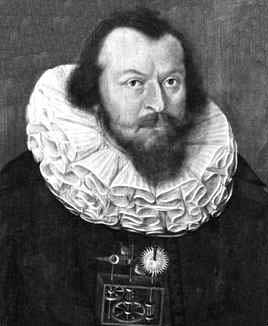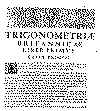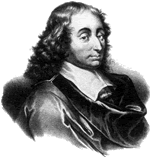click on the home button to go to the home page
|
The era of Antiquity 1620 - 1671 The era of Antiquity can be seen as the era of calculator
devices that had no memory and no means to output the results other
than dials or indicators. |
pre history | antiquity
| pre industrial era | industrial
era
1620 -
1672 - 1773 - 1810
- 1830 - 1846 - 1874
| Related Articles |
| Related Resources |
|
pre history |
Ruler with logarithmic scales made by Gunter. Gunter mounted this lines, together with other lines giving the logarithms of trigonometric functions, upon a ruler or scale, commonly called "Gunter's scale" (10)
![]() The
Calculator Ruler, an improved and possibly
simplified model of the calculator disc was invented.
The
Calculator Ruler, an improved and possibly
simplified model of the calculator disc was invented.
This ruler stayed the most important calculating tool for engineers and others until well into the 1970's, when electronic calculators became available at affordable prices in the form of the Hewlett Packard HP35 scientific calculator.
(1620)
![]() William
Oughtred (1575-1660) invents, on the basis of Napiers' theory, the logarithmic
calculating disk. (1644(8a) 1622(11a),
1632(7)
William
Oughtred (1575-1660) invents, on the basis of Napiers' theory, the logarithmic
calculating disk. (1644(8a) 1622(11a),
1632(7)
But Oughtred did not think his invention is worth publishing. Others improved on his design. But it will take until 1850 for this tool to be improved by a French officer Amedee Mannhein in the form of a slide ruler, to become generally accepted by others than scientists and mathematicians. Until then it was regarded as a "toy" for the latter.
However his invention is disputed by one of his students: Richard Delamain (1600-1644) and later fellow. It is presumed that Oughtred was there first but Delemain was the first to publish. It is undisputed that Oughtred invented the rectilinear sliderule in 1633.(9)
1624(1)

![]() Dr.
Franz Hammer of Stuttgart, while he researched Johann Kepler's papers, discovered
some letters from Prof. Wilhelm Schickard (1592-1635), a professor at the University
from Tübingen (Germany). The letters described the working of a calculating
mechanism.
Dr.
Franz Hammer of Stuttgart, while he researched Johann Kepler's papers, discovered
some letters from Prof. Wilhelm Schickard (1592-1635), a professor at the University
from Tübingen (Germany). The letters described the working of a calculating
mechanism.
In a letter dated September 1623, Schickard wrote: "The same thing which
you have done by hand calculation, I have just recently tried to do in a mechanical
way."
"I have constructed a machine which automatically reckons together the given numbers in a moment, adding, subtracting, multiplying and dividing."
The next letter contained sketches of the machine, and a third told the sad story of the machine being destroyed by fire. No records exist of the events that led Schickard to build a calculator, although he was familiar with Napier's logarithms and his bones.
It's hard to tell how successful his machine would have been because he didn't rebuild it. But he would have had to overcome the problems that the inventors of this visionary period encountered, such as lack of precision and over-rotation of the wheels.
It is was construction that shifted a 1 to the left when the sum of a certain
column became greater than 9. This was the first known description of an adding
machine.
It also was the first counting mechanism that added and subtracted with automatic
carry of tens and with 6 digits. It is called a "Calculating Clock"
(ref. Niel Brandt 1994), see picture below.
The mechanism was said to be designed for the astronomer Kepler who wanted to
perform calculations on the paths of stars and other celestial bodies. It was
Dr. Bruno Baron von Freytag Löringhoffater, with the help of sketches and copperplates,
who managed to build a reconstruction.
Since no original copies of Schickard's machine have been found the credit for
the first adding machine with automatic carry is often given to Blaise Pascal.23
Finding a way to transport or 'carry' the tens turned out to be a very important
development, which we now consider obvious.
But we should not forget that in this time everything, including calculation,
was done by hand or heart. A relatively small business easily employed a few
dozen of calculators. The few people with knowledge of counting and calculation
were held in high esteem. The technology of using gears was only known to a
few engineers. And in this light, a mechanism that counts the tens automatically
was an invention of extraordinary proportions.
 |
![]() In
this year Henry Briggs published
his first logarithmic table with base 10
In
this year Henry Briggs published
his first logarithmic table with base 10
![]() Descartes
formulated the theorem of optical breaking and the principles of modern analytical
geometry.
Descartes
formulated the theorem of optical breaking and the principles of modern analytical
geometry.
Descartes is a skeptic, a classical philosophical trend which gained a following in the seventieth century. He drove skepticism to the extreme in his
Discours de La Methode.
In which we wrote his famous conclusion: I think therefore I am
This statement contributed tremendous to the phylosophical thinking in the 'Age of Enlightenment' and shaped the deterministic approach of the world like the western civilization uses now.

![]()
 Blaise
Pascal (1623-1662) from France developed a mechanism to calculate with 8
figures and carrying of 10's , 100's, and 1000's etc. (nine-s complement)
Blaise
Pascal (1623-1662) from France developed a mechanism to calculate with 8
figures and carrying of 10's , 100's, and 1000's etc. (nine-s complement)
The machine is called the 'Pascaline'
but the machine never performed flawlessly and didn't sell.
While several models were completed, Pascal's machine was more likely
to be found in the living rooms of their owners as a conversation piece rather
than in the work room.
Pascal tried many different methods and some 50 models were discarded. He truly believed that his machines would save men hours of labor. However, they did not work well. Accurate gear cutting was difficult in that time. The mechanisms were always out of alignment and only Pascal and one of his workmen could fix them.(11b)
![]() One
of the first references to the word COMPUTER is given by Sir
Thomas Brown. He spoke of : "The calendars of Compotystes.(2)"
One
of the first references to the word COMPUTER is given by Sir
Thomas Brown. He spoke of : "The calendars of Compotystes.(2)"
The technological advances in watchmaking caused many watchmakers to design calculators based on Pascal's original designs. This one is a fine example by J. Sauter, displayed at the Science Museum in London, UK.
![]() Sir
Samuel Moorland, master of mechanics to King Charles II of England, designed
a more or less mechanized sector: "the trigonometrically calculating machine".
Sir
Samuel Moorland, master of mechanics to King Charles II of England, designed
a more or less mechanized sector: "the trigonometrically calculating machine".
A sector was the forerunner of the slide rule like it was used between 1950-1980
and looked like a pair of compasses, with numbers engraved at specific distances
on the legs. The width (span) of the legs in combination of the engraved numbers
could be used to multiply in some way. Moorland put a few gears on the sector
that mechanized the contraption. He also improved on the Pascaline
Sir Samuel Morland constructed the money adder(13); a non-decimal adding machine suitable for use with English money. It uses auxiliary dials instead of a carry meachanism and this required the user to re-enter the numbers manually.(18) This is the first calculator in the UK.
![]() Blaise
Pascal's Pensées published posthumously. This work became very
important and of great influence on the way of thinking of the western world.
Blaise
Pascal's Pensées published posthumously. This work became very
important and of great influence on the way of thinking of the western world.
![]()
| Last Updated on 22-jun-04 | For suggestions please mail the editors |
Footnotes & References